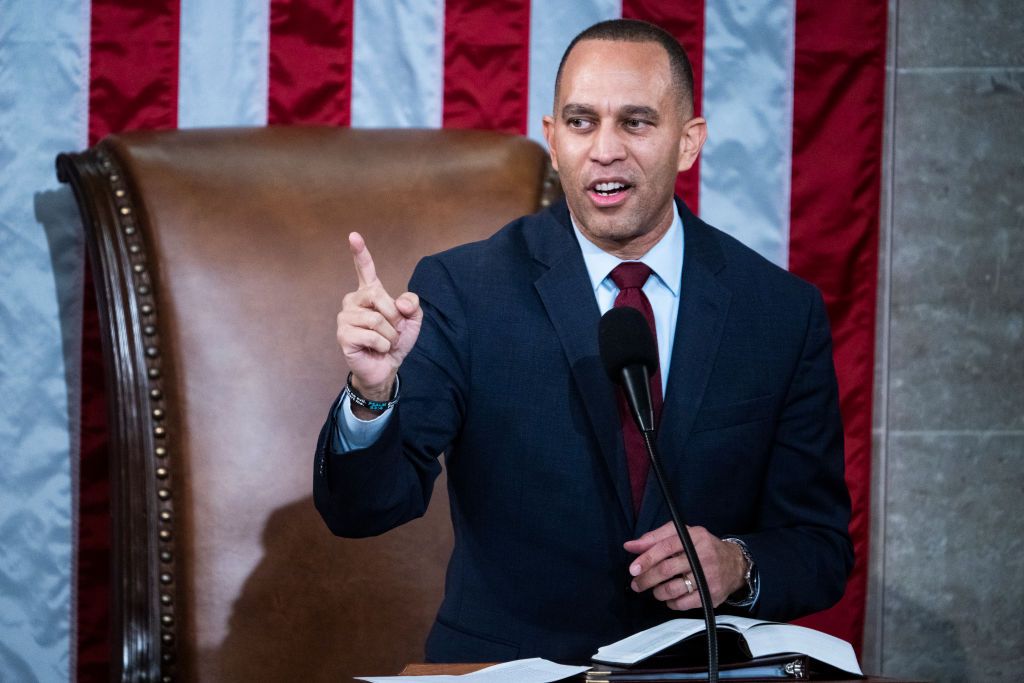
The Democratic Party is experiencing a crisis of unprecedented proportions, with voter registration numbers plummeting and its once-stronghold states slipping away.
A recent analysis by The New York Times has exposed a staggering trend that shows the party losing 2.1 million registered voters in just four years, while Republicans surged ahead with a gain of 2.4 million.
The GOP now holds a 4.5 million voter advantage over the Democrats, marking a seismic shift that could potentially signal the beginning of the Democratic Party’s decline into political irrelevance.
Michael Pruser, the director of data science for Decision Desk HQ, spoke candidly about the implications of this shift, suggesting that this isn’t just a temporary blip but a potential "death spiral" for the Democratic Party.
“This isn’t just a dip—it’s a potential death spiral for the Democratic Party,” Pruser remarked in an interview with The New York Times. His conclusion was grim: “There is no cavalry coming across the hill.”
The numbers, according to analysts, reflect a long-term, systematic erosion of the party's base that could have far-reaching effects on future elections, including the 2026 midterms and the 2028 presidential race.
The voter registration loss is not confined to one region or state but is felt across the nation, especially in battleground states that are crucial to the Democratic Party’s chances in future elections.
In North Carolina, a state that has been a significant battleground in recent elections, Democrats lost over 115,000 registered voters between 2020 and 2024, while Republicans gained more than 140,000.

This shift has effectively erased the Democrats' longstanding advantage in the state, a worrying trend for party strategists as North Carolina continues to become more favorable to the GOP.
Pennsylvania and Arizona, two states that played pivotal roles in the 2020 presidential election, are also showing similar patterns. Both states recorded shifts toward the GOP, with Democrats losing significant numbers of voters and Republicans making significant gains.
Nevada, once considered a reliable blue state, saw some of the steepest Democratic losses in the nation. Even in deep-blue West Virginia, the loss of Democratic voters was more significant than in many other parts of the country.
Perhaps most concerning of all, traditional Democratic strongholds such as New York and California are also showing signs of distress. New York Democrats lost more than 305,000 registered voters during this period, while California saw an eye-popping drop of 680,000 voters from its rolls.
The loss of so many voters in these historically blue states is a wake-up call for the party and signals the extent of the damage.
Nationally, the Democratic Party's advantage in voter registration has shrunk dramatically. In 2020, Democrats held an advantage of nearly 11 percentage points over Republicans in terms of registered voters.
By 2024, that advantage had dropped to just over six percentage points, a dramatic shift in just four years. This loss of voters is not just a matter of losing existing supporters; it also reflects the failure to attract new voters, particularly young people and working-class voters, who have traditionally been part of the Democratic base.
The most troubling statistic for Democrats is that more new voters registered as Republicans than Democrats in 2024, the first time this has happened since 2018.

In 2018, Democrats accounted for 34% of new voter registrations nationwide, compared to just 20% for Republicans. However, by 2024, the GOP had caught up and even surpassed the Democrats, with 29% of new registrations compared to 26% for the Democrats.
The Times report concluded that the Democratic Party is "hemorrhaging voters long before they even go to the polls," highlighting the severity of the problem.
This shift in voter registration is a clear indication that the Democratic Party is losing its grip on the electorate. Analysts suggest that this could explain why President Donald Trump, despite his polarizing rhetoric, managed to win the national popular vote in 2024, marking the first time in 20 years that a Republican won the national popular vote.
The loss of key voter groups, particularly in battleground states, could spell trouble for the party as it heads into future elections.
Republican operatives have credited their success in voter registration to a stronger ground game and clearer messaging. Sean Spicer, the former press secretary for Donald Trump, recently discussed the GOP’s success on Megyn Kelly’s show, claiming that the Republican Party had mastered both the "mechanics and the message," while the Democrats have failed to connect with voters.
“The Democrats don’t have either at the moment,” Spicer said. “That will prove to be impactful not just in the 2026 midterms, but in the subsequent presidential election as well.”
This assessment of the Democratic Party’s weaknesses is echoed by many political analysts, who argue that the party has lost touch with the concerns of everyday voters.
While the GOP has capitalized on issues like immigration, crime, and economic concerns, the Democratic Party has struggled to offer a compelling vision that resonates with the broader electorate.

The party's focus on progressive ideals and "woke" politics has alienated many working-class voters, particularly in swing states, who feel that the Democratic Party is no longer focused on their needs.
Even within the Democratic Party, there is growing acknowledgment of the scale of the problem. Former Democratic strategist Dan Turrentine admitted that the party has squandered its once-vaunted edge in voter registration efforts.
“It’s what the party has kind of hung its hat on now going back to 2008,” Turrentine said. “But it turns out the Republicans have leapt so far ahead of us that we now have a serious problem.”
Turrentine's comments reflect a growing sense of frustration among Democratic strategists who feel that the party's past successes have not translated into long-term political dominance.
Voter registration efforts, which have been a cornerstone of the Democratic Party’s strategy for years, are no longer producing the results they once did. In key cities like Philadelphia and Atlanta, Democratic organizers have reported hearing voters express support for Donald Trump rather than Democratic candidates.
"Yes, I’m voting—but the problem is, it wasn’t for Kamala Harris. It was for Donald Trump," said one organizer, highlighting the deepening divide within the party’s base.
Veteran political analyst Mark Halperin pointed out that the Democratic Party has ignored warning signs for far too long. “This has been going on for a long time. This is not some breaking news,” Halperin said.
“It’s partly the Democrats’ ‘woke’ weakness; it’s partly Trump; but part of why this happened is the Democrats and their allies in the media live in a blue bubble. This alarm should have been pulled years ago.”

Halperin's comments reflect a growing realization within the party that its focus on progressive ideals and identity politics may have alienated key voter groups.
The Democratic Party’s increasing reliance on left-wing activism and its failure to address the concerns of more moderate voters may have contributed to its decline in voter registration.
Looking ahead, the Democratic Party faces a challenging road. As voter registration continues to decline, party leaders must find a way to reconnect with disillusioned voters and rebuild trust with key constituencies.
The trend lines suggest that without a fundamental shift in the party’s approach, Democrats could face even greater losses in future elections, particularly in swing states that will be crucial in the 2026 midterms and the 2028 presidential race.
The Democratic Party must also address its messaging problem. While Republicans have successfully appealed to working-class voters with promises of economic growth and national security, the Democratic Party has failed to offer a compelling vision that resonates with the broader electorate.
To reverse the trend, the party will need to find a way to bridge the divide between its progressive base and moderate voters, while also addressing the concerns of working-class Americans who feel left behind by the political establishment.
The Democratic Party is at a crossroads. With voter registration numbers plummeting and key battleground states shifting toward Republicans, the party faces an existential crisis.
Analysts warn that this could signal the beginning of a long-term decline in the party’s political relevance. If Democrats are to remain a dominant force in American politics, they will need to address their weaknesses, reconnect with voters, and offer a vision for the future that appeals to a broader electorate. Whether the party can rise to the challenge remains to be seen, but the stakes have never been higher.


-1749890798-q80.webp)
